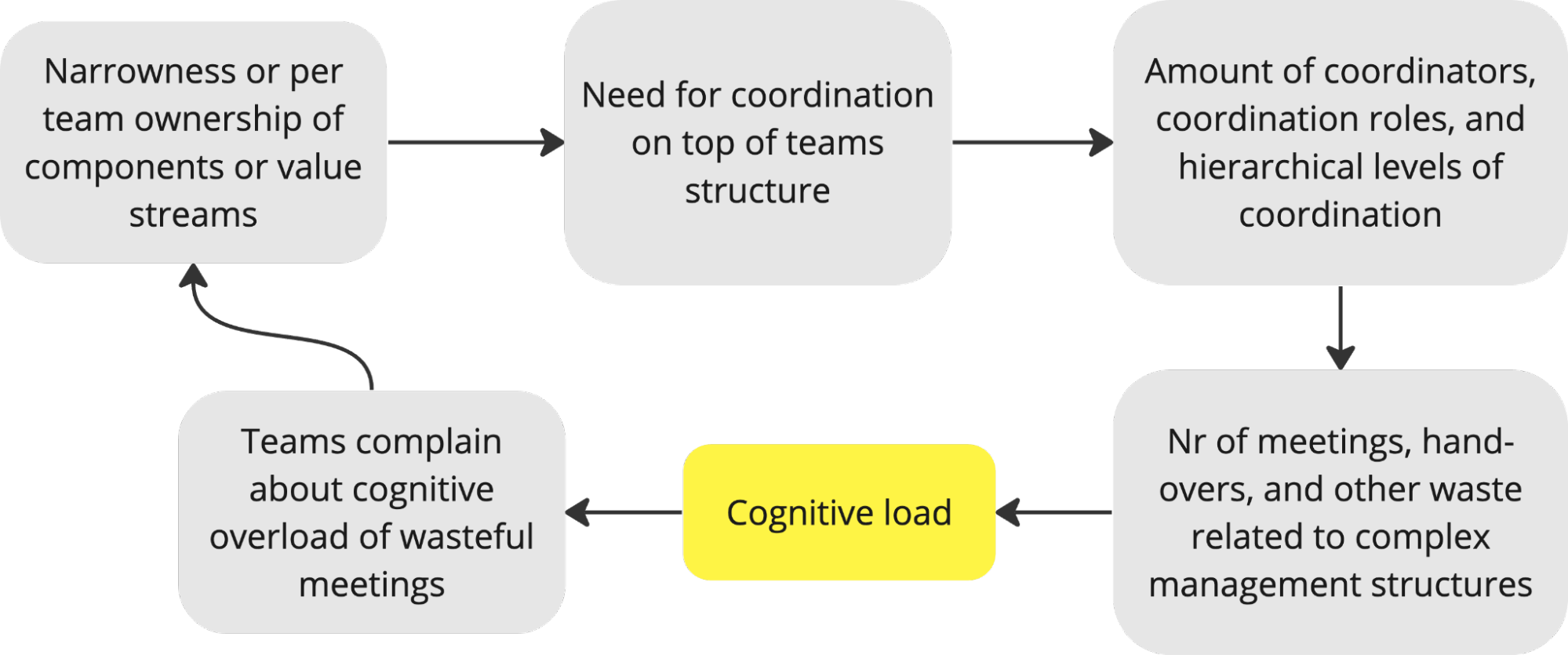Consequences of Technical Ownership
Technical ownership, while prevalent in many organizations, often brings with it a slew of unintended negative consequences, particularly in environments where agile responsiveness and team integration are crucial. Let's delve into some of the challenges that stem from this model:
-
Increased Complexity and Reduced Focus: When teams are assigned narrow ownership over specific components or value streams, the focus can become too localized, potentially leading to broader, more critical business objectives being ignored. This segregation often leads to inefficiencies as not all components require equal attention simultaneously. Teams responsible for less critical components might find themselves without essential tasks, leading organizations to assign work just to keep everyone busy. This misalignment can detract from focusing on what truly matters for the business.
-
Excessive Cognitive Load and Reduced Efficiency: Narrow ownership leads to scenarios in which teams are not just working on their primary tasks but are also juggling multiple unrelated tasks to fill their workload. This constant context switching heightens cognitive load and diminishes overall efficiency. Each team's product backlog becomes a battlefield of competing priorities from different projects, with product owners overwhelmed by the task of balancing these divergent demands. The resultant complexity is not just a burden for the teams but also leads to suboptimal outputs that may not align with strategic goals.
-
Isolation from Broader Goals, and Customer Needs: With technical ownership, teams often become siloed, focusing more on their technical tasks rather than the end-to-end product development and customer satisfaction. This isolation can lead to a disconnect from real customer needs, as teams lose sight of how their work fits into the larger picture. The narrow scope of work might make teams proficient in their specific areas, but it hinders their ability to contribute to and engage with overarching business outcomes.
-
Resource Allocation Challenges, and Knowledge Silos: As requirements scream for attention and resources, management faces the challenge of reallocating resources efficiently. The rigid structure of technical ownership can lead to resource bottlenecks—for example, certain teams may become understaffed at critical times, while others may have excess capacity. Furthermore, this model often results in knowledge silos, where expertise is confined within small groups, increasing the risk associated with personnel changes and reducing the organization’s flexibility to adapt to new challenges.
In essence, while technical ownership might simplify certain aspects of management and supposedly reduce cognitive load by clearly defining responsibilities, it often introduces more significant systemic issues that can hinder an organization's adaptability, efficiency, and alignment with broader business objectives.
Rigid technical ownership consequently leads to over-complicated organizational structures and processes. Why? Because there is an increased need for specialized coordination roles outside of the primary teams, adding another layer of complexity to organizational structures.
Increased Need for Coordination Roles
In environments where teams own specific technical components, there is often a gap in how these components integrate with the larger system or product. To manage this gap, organizations frequently establish roles such as project managers, integration specialists, or system architects, whose primary responsibilities involve ensuring that the work of different teams aligns with overarching project goals and timelines. These roles are crucial in bridging the gaps between teams that might otherwise operate in isolation due to their narrow scopes of ownership.
Resource Allocation and Team Formation Challenges
The specialization inherent in technical ownership can lead to a static allocation of resources, where people or entire teams are assigned to specific components or projects without consideration for changing priorities or needs. This situation necessitates a dynamic approach to resource management, where resource allocation needs constant adjustment to address shifting business priorities. Special coordinators or resource managers often take on this role, deciding how best to deploy personnel to maximize efficiency and meet strategic objectives.
Increased Organizational Complexity
The introduction of specialized coordination roles inherently complicates organizational structures. Each additional layer of management or coordination introduces potential bottlenecks and slows down decision-making processes. This complexity can lead to inefficiencies and increased operational costs as more time and resources are spent on managing managers and coordinators rather than focusing on actual value-creating activities. Furthermore, these layers can dilute the clarity of communication, leading to a loss of focus and misalignment between the work being completed and the organization’s strategic goals.

Dependency Management
Special coordination roles often become necessary to manage dependencies that arise between teams. As teams focus narrowly on their components, they may not have visibility of how their work affects other parts of the system. Coordinators are tasked with overseeing these interdependencies, ensuring that integration points are managed effectively, and that projects progress without delays caused by unresolved dependencies.
Implications for Agility and Responsiveness
While these coordination roles are intended to enhance efficiency and alignment, they can inadvertently make the organization less agile and responsive to changes. The additional layers of oversight and decision-making can slow down responses to market shifts or emerging opportunities, as actions may require multiple approvals or adjustments to coordinated plans that span multiple teams.
In summary, while technical ownership can bring clarity and focus to individual teams’ responsibilities, it often leads to the necessity for increased coordination, which complicates organizational structures and can hinder overall agility and efficiency.
To conclude this chapter, it is crucial to recognize the implications of how boundaries are set within organizational responsibilities. The more narrowly these boundaries are defined, the more severe the consequences tend to be, manifesting in increased silos, inefficiencies, and coordination challenges. Conversely, the more broadly boundaries are set, the less the consequences manifest themselves. This kind of ownership model challenges the organization to find a balance between specialized expertise and the flexible, integrated collaboration required to adapt quickly in dynamic markets.
As we transition to the next chapter, we will explore the concept of operating without fixed boundaries, delving into how such an approach could potentially transform organizational dynamics and enhance overall performance.